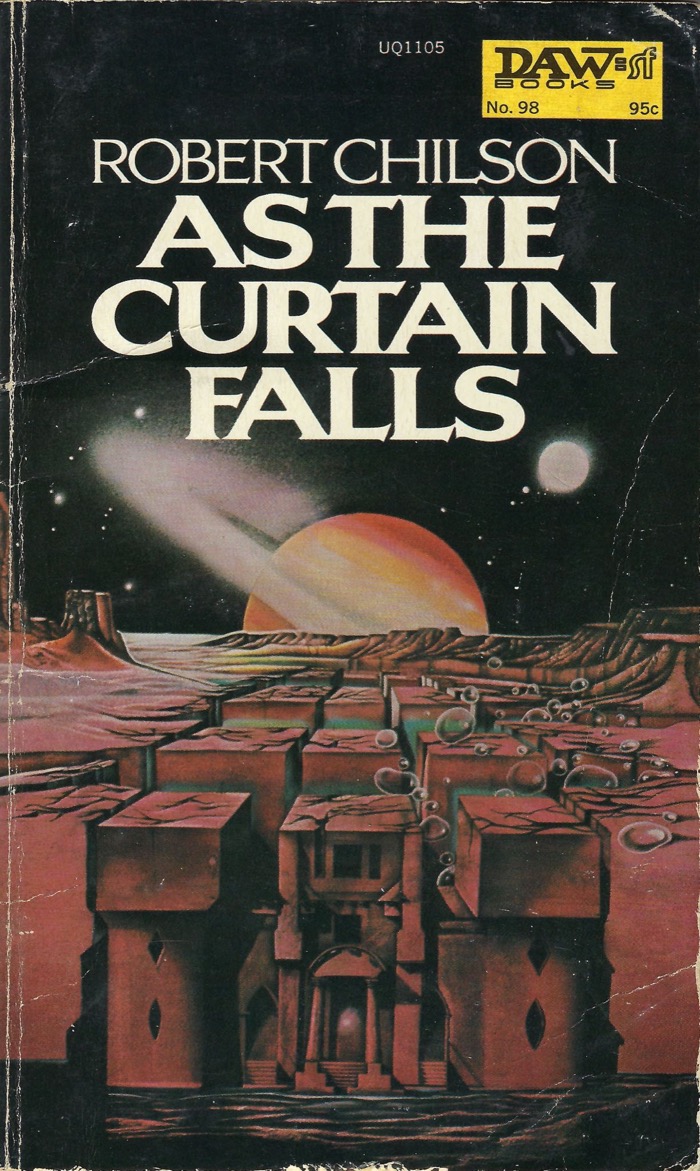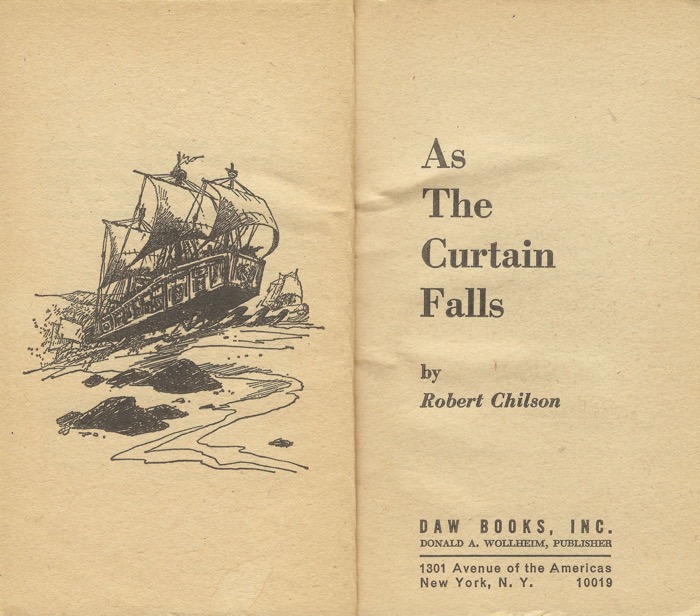As the Curtain Falls
Reviewed date: 2019 Aug 5
Rating: 2
174 pages
From the back cover:
A BILLION YEARS HENCE
In the old age of the once great planet Earth, the oceans have long dried up, and in their empty sea bottoms stand the last cities of mankind, for the once mighty continental heights are barren and frigid.
The world is strewn with the ruins of star-faring civilizations of the Dawn ages, and somewhere in those ruins lies the legendary Kingsworld Legacy1--which may yet save humanity.
Trebor of Amballa possesses the key to the Legacy. But can he use it--and will the remnants of a myriad lost nations let him?
Robert Chilson paints a colorful and vivid picture of the farthest future, tinted with wit and a tinge of bitter iron.
1. It's the Kinsworld Legacy, not Kingsworld. I guess nobody proofreads the back cover copy.
Limned
This book hooked me with the first word.
Limned against the sun on the far edge of the world, the city floated on a sea of gold.
Limned. A glorious word: limned. Perhaps my favorite word. I had to read this book. Unfortunately, after the first addicting word, it was all painful.
Trebor
The story opens as Trebor is making his way to a clandestine meeting in a deserted ancient ruin. But--hold! Trebor? The protagonist's name is Trebor? The author's name is Robert Chilson. Robert Chilson. Trebor. Robert. Trebor. Robert. Trebor. TREBOR IS JUST ROBERT SPELLED BACKWARDS! Oh, but there's more.
Trebor, son of Sirrom
Wait, is Robert Chilson's father named Morris? Did I just figure out a hidden clue? This led me on a wild internet search. I can't be certain, but I found birth and death records for a Morris Chilson that match what Robert Chilson's website says about his father, so I'm going to put this into the win column for me. But we're not done. Oh no.
Trebor, son of Sirrom, son of Leinad the Buller
Grandpappy was a cowboy named Daniel!
Trebor's Quest
Trebor is making his way to a clandestine meeting in a deserted ancient ruin. He's seeking allies in some sort of political intrigue, and the price of this alliance turns out to be an arranged marriage with Viani, the daughter of a powerful man from Linllallal. But none of this is explained in any detail. Instead, the author gives us page upon page of scenery, geography and history. This is an inconceivably old world and Chilson hammers that home at every opportunity. Every opportunity. It's history, history, history until a swordfight breaks out on page 17--but just as the action is heating up, we break for a history lesson about Trebor's sword:
Three men held a narrow street mouth, skilled fencers. Others held chanchids behind them. The Linllallalan bore rather short, broad swords; their art was mostly with the edge. Trebor crowded past, his own long, thin sword in hand.
His sword was of a metal that never corroded, that was so hard that a whole grandstone was worn away each time it was sharpened, which was not once in a lifetime. It had a hilt and a broad guard, but the blade remaining was less than the width of Trebor's little finger, though no man could break it. The Pramantines of the Dawn had declared it to be in the style of the First Irenic Empire, which was an aping of the styles of the relics of the Empire of the Sun in the grand old days of the Dawn, the Elder Worlds, the Age of Grace. Trebor had observed that it was being eroded away at a rate that made an age greater than ten thousand years highly unlikely, less than that since the Third Empire; but of course the blade could have laid for ten times that in some old ruin.
The action and plot are less important than setting. Everything, and I mean everything, is turned into a history lesson. For example, after the swordfight Trebor finds that Viani has been kidnapped. Despite having declined the arranged marriage, Trebor is forced to mount a rescue attempt, so he sets out. But first, some geography:
The land fell away before Trebor like the edge of the world. Beneath his feet, as it seemed, lay the Downland of Iréné a mile below. Actually not the mightiest archer with the strongest bow could have put an arrow into the tumbled foothills at the bottom of the Up Land's Face, but so steep was it and so high that it seemed vertical. Downlands such as Iréné cover three-quarters of Aera.
Behind him lay Rhodrora, a gem of glowing rose just under the hang of purple mountains beyond. Except for the shelf, nothing but sere desert lay behind him; the Uplands were the driest of deserts, spawning nothing but mighty dust storms. Life existed solely in the Downlands.
Iréné did not seem to smile. Before him lay the glaring salt desert of the Shimmering Shuns, an old sea bottom; far out on it was a bright-colored sail. A hundred miles south, at Gamelumes, the Shuns gave way to the higher sand desert of the Duneland. North the Shuns faded out, beyond the marshes of Paish, into desert hills. West of him, across the Shuns, ran the slash of Darkling Fell; beyond, the sand desert of the Overfells. Beyond that, through the valley of The Shamsund, ran the great river, Annas Annanda. On it, halfway between its mouth at Trepidation Marsh in the south and its head in the Arctic Marshes, was the proud trading city of Amballa.
Southwest of Amballa, the river Anna Vallanda emptied into the great river, flowing through the heavily irrigated valley of Lin Llallal, almost as rich as The Shamsund, that crazy patchwork of tiny kingdoms. Still farther to the southwest was the fair land of Aetha, last outpost of civilization, indeed of life itself, in Iréné.
This geography lesson segues seamlessly into a history lesson.
A hundred thousand years ago, following the ten-times-longer Dark Ages, the Golden Imperators fought out the unification of Iréné, including parts now gone in desert. Then the great Trepidation Marsh and the Hackmatack Forest south of it were under the waters of the Stacienndanies of Aera: The Last Salt Sea of Earth. Now North Iréné was waters only by the melting of the Arctic Iceland; South Iréné not at all.
In those days, traders werent over the far Faringland into South Iréné, and southwest by way of fair Aetha and the Bitter Land to the rich Downland of Favonia, and they went north over the Iceland to the narrow Downland, Aléné. After the fall of the First Irenic Empire, this trade was lost, save only that to the north. That too was lost in the fall of the Second Empire, and when in the Third Empire, some fifteen thousand years ago, they sought to reestablish it, the traders found in Aléné only a vast and lifeless desert.
None of this geography or history is relevant to the plot. It's set dressing.
Sandships
Mercifully, the geography and history lessons pause for a fantastic sequence featuring a battle between sailing ships. These wooden sailing ships are fitted with steel runners and skim across the salt-encrusted deserts that were once the ocean bottom. I'm a sucker for wooden land ships. I loved the ice sailing ships in Alan Dean Foster's Icerigger trilogy. I enjoyed the ice ship in Michael Moorcock's The Ice Schooner. And I remember fondly the rickety wooden ground-ships from Edgar Rice Burroughs in Escape on Venus.
But all too soon, it's back to history.
The Problem With Trebor
We know nothing about him. He's rather cavalier about killing. But the author does not explain his origins or motivations. He spends half the book chasing after Viani in a rescue attempt, then appears to abandon her, and finally decides to go look for the Kinsworld Legacy. Why? We don't know. But as I suspected, Trebor turns out to be no hero. In the final paragraphs, he reveals his motivations: power. He desires nothing more than to conquer the world and establish his own empire.
LOTR minus The Rings
There's something to be said for creating a fictional world with a rich and complex history. Tolkien did it for Middle-earth. But Tolkien told a story. The Lord of the Rings weaves in tidbits of history along with the story, but the compelling tale is there. And for those whose curiosity is aroused and want to know more, there is The Silmarillion.
In contrast, As the Curtain Falls is like The Lord of the Rings but with the compelling story subtracted. What's left is the barest of stories that exists as a frame for displaying all the tidbits of backstory and history. Those tidbits serve to pique our interest, but there are too many of them, too disjointed, too unconnected with each other. And there's no Silmarillion to tell the bigger story.

